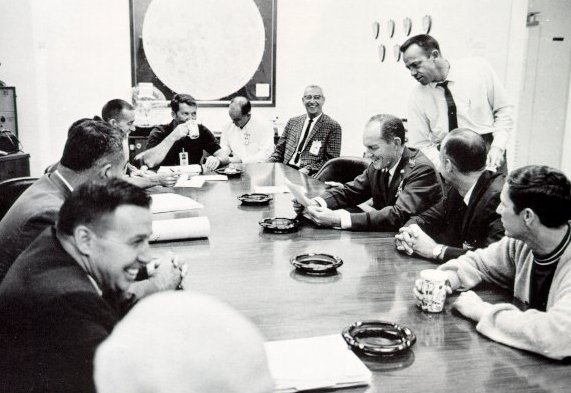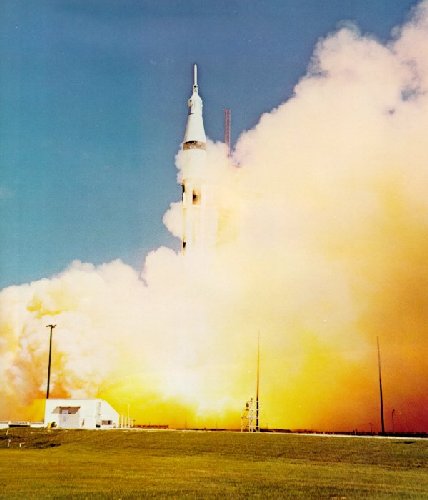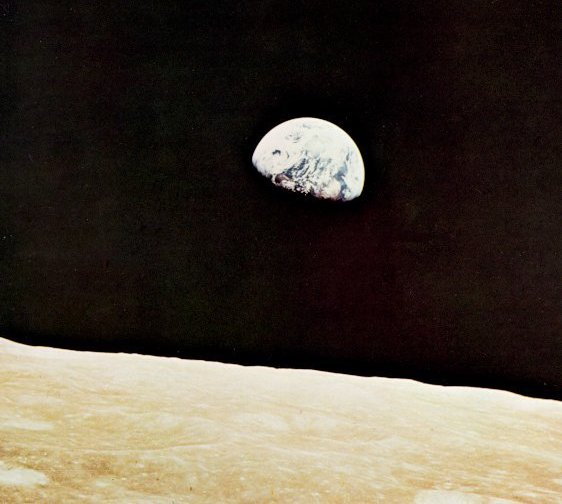
AN EARLY TRIP AROUND THE MOON
George Low, the spacecraft program manager, then put forward a daring idea: fly the CSM on the Saturn V in December, with a dummy instead of the real LM, all the way to the Moon. We would then make maximum progress for the program, while we took the time necessary to work out rigorously the LM problems. Low had discussed the feasibility of such a mission with Gilruth, Kraft, and Slayton at the Manned Spacecraft Center; I was at the Kennedy Space Center in Florida when he called to voice his idea. The upshot was a meeting that afternoon of the Apollo management team. The Marshall Space Flight Center at Huntsville, Ala., was a central point, considering where we all were at the moment. George Hage, my deputy, and I joined with Debus and Petrone of KSC for the flight to Huntsville. Von Braun, Rees, James, and Richard of MSFC were there. Gilruth, Low, Kraft, and Slayton flew from Houston.

|
| A prelaunch conference at Cape Kennedy shows no sign of prelaunch tension. Apollo 7 Commander Wally Schirra raises his coffee cup, with Cunningham at his right. Eisele is at the extreme right, in sweater. Al Shepard looks over General Phillips' shoulder. At Phillips' left is George Low; across the table is Rocco Petrone. |
We discussed designing a flexible mission so that, depending on many factors, including results of the Apollo 7 flight, we could commit Apollo 8 to an Earth-orbit flight, or a flight to a few hundred or several thousand miles away from Earth, or to a lunar flyby, or to spending several hours in lunar orbit. The three-hour conference didn't turn up any "show-stoppers". Quite the opposite; while there were many details to be reexamined, it indeed looked as if we could do it. The gloom that had permeated our previous program review was replaced by excitement. We agreed to meet in Washington five days later. If more complete investigation uncovered no massive roadblocks, I would fly to Vienna for an exegesis to my boss, Dr. George E. Mueller, Associate Administrator for Manned Space Flight, and to the NASA Administrator, James Webb, who were attending a United Nations meeting on the Peaceful Uses of Outer Space. (Going to Vienna was at first considered necessary, lest other communications tip off the Russians, believed to be planning a Moon spectacular of their own. Eventually it was decided that my appearance in Vienna would trip more alarms than overseas telephone conversations.)
Many problems remained. The high-gain antenna was an uncertain quantity; but Kraft agreed that the mission could be flown safely with the omniantennas, even though television might be lost. What should we carry in lieu of the LM? The answer was the LM test article that had been through the dynamics program at Marshall. Deke Slayton wanted to leave McDivitt and his crew assigned to the first LM mission; so the next crew, Borman, Lovell, and Anders, scheduled for the E mission, were brought forward for the newly defined Apollo 8 mission. McDivitt's mission retained its D designation, and Borman's was labeled "C-Prime".
Upon returning to Washington, I presented the plan to Thomas O. Paine, Acting Administrator in Webb's absence. Paine reminded me that the program had fallen behind, pogo had occurred on the last flight, three engines had failed, and we had not yet flown a manned Apollo mission; yet "now you want to up the ante. Do you really want to do this, Sam?" My answer was, "Yes, sir, as a flexible mission, provided our detailed examination in days to come doesn't turn up any show-stoppers." Said Paine, "We'll have a hell of a time selling it to Mueller and Webb."
He was right. A telephone conversation with Mueller in Vienna found him skeptical and cool. Mr. Webb was clearly shaken by the abrupt proposal and by the consequences of possible failure.

|
| Lifting off for the first time with men aboard, the Saturn IB and its hydrogen-fueled upper stage carry the Apollo 7 command and service module toward Earth orbit. This was the first trial of the intensively reengineered CSM, and to the relief of NASA it performed beautifully, staying in orbit for 10.8 days, longer than a Moon landing mission would require. |
On August 15 Paine and I sent Webb and Mueller a seven-page cable with suggested wording of a press release saying lunar orbit was being retained as an option in the December flight, the decision to depend on the success of Apollo 7 in October. Webb replied from Vienna via State Department code, accepting the crew switches and schedule changes. But he proposed saying only that "studies will be carried out and plans prepared so as to provide reasonable flexibility in establishing final mission objectives" after Apollo 7.
Paine interpreted Webb's instructions "liberally", and authorized me to say in an August 19 press conference, upon announcing the McDivitt-Borman switch, that a circumlunar flight or lunar orbit were possible options. I am told that I diminished the possibility so thoroughly, by saying repeatedly "the basic mission is Earth orbit", that the press at first mostly missed the point.

|
| An exciting Earthrise greets the Apollo 8 crew as they return from the far side of the Moon. This was the first time men had ever directly seen Earthrise or the far side, though photos had been taken earlier. Potential landing sites were photographed from the 70-mile-high orbit. |
October 11 at Cape Kennedy was hot but the heat was tempered by a pleasant breeze when Apollo 7 lifted off in a two-tongued blaze of orange-colored flame at 11:02:45. The Saturn IB, in its first trial with men aboard, provided a perfect launch and its first stage dropped off 2 minutes 25 seconds later. The S-IVB second stage took over, giving astronauts their first ride atop a load of liquid hydrogen, and at 5 minutes 54 seconds into the mission, Walter Schirra, the commander, reported, "She is riding like a dream". About five minutes later an elliptical orbit had been achieved, 140 by 183 miles above the Earth. The S-IVB stayed with the CSM for about one and one-half orbits, then separaten. Schirra fired the CSM's small rockets to pull 50 feet ahead of the S-IVB, then turned the spacecraft around to simulate docking, as would be necessary to extract an LM for a Moon landing. Next day, when the CSM and the S-IVB were about 80 miles apart, Schirra and his mates sought out the lifeless, tumbling 59-foot craft in a rendezvous simulation and approached within 70 feet.
|
Graduated missions led confidently to a landing on the Moon We designed seven types of missions to test the suitability and safety of all equipment in all mission phases. These were designated by letters A through G:
- S. C. P. |
| Next |